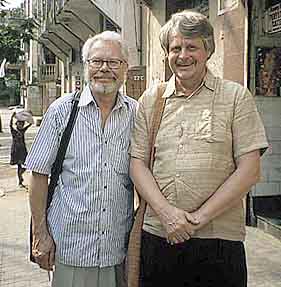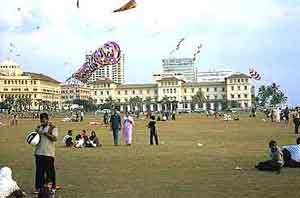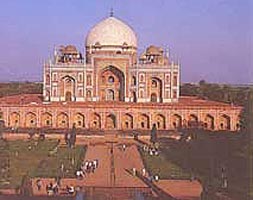SWEDISH SOUTH ASIAN STUDIES NETWORK
So different, so similar!
Report from a SASNET contact journey to South Asia, in February–March 2002
by Lars Eklund and Staffan Lindberg
| The Maldives | Sri Lanka | India/New Delhi | India/Hyderabad |
| India/Varanasi | India/Kolkata | India/Shantiniketan | Bangladesh |
 Between
25 February and 23 March 2002 we made a rather fantastic journey into
known and unknown terrain of South Asian academic institutions in the
Maldives, Sri Lanka, India, and Bangladesh. The purpose was to network
with researchers and institutions, and get to know under which conditions
and with what expectations they function.
Between
25 February and 23 March 2002 we made a rather fantastic journey into
known and unknown terrain of South Asian academic institutions in the
Maldives, Sri Lanka, India, and Bangladesh. The purpose was to network
with researchers and institutions, and get to know under which conditions
and with what expectations they function.
We snowballed on the basis of our own and other Swedish researchers´ existing networks in South Asia. What difference could contacts and co-operation with Swedish researchers mean to them? Who could be possible partners in various projects and ventures?
Most people we met were social scientists, but often with contacts in other disciplines. However, in the Maldives and Sri Lanka we met with many humanists and natural scientists.
The Maldives
Our first stop was Malé, capital of the Maldives – an Islamic republic consisting of 1 200 islands set in the Indian Ocean near to the Equator. Here we met with an extraordinary beautiful archipelago, whose existence though is acutely threatened due to the global green house effect. We met two ministers and several researchers during our two days visit, and they were all very positive towards SASNET.
The country has a long history of International trade, but it opened up to the World only recently, awakening from nearly 100 years of isolation. Therefore they welcome proposals for co-operation in the field of research. Primary education has reached to the 270 000 inhabitants, out of which almost 95 % are literate, and young people are going abroad to a great many countries for higher education. Till a few years ago no higher education was available in the Maldives, but now we learnt that the College for higher education is going to be upgraded to a university proper before 2005.
More information on our metings at the Maldives
Besides tuna fishing, up market tourism is today the mainstay of the country´s economy. We had the opportunity to visit one of the 80 tourist resort islands, this one located in the South Male atoll. Here we spent a day, snorkling the coral reefs, besides studying the leisurely life style of the mostly Western and Japanese tourists. Around 400 000 tourists visit the country every year, but the terror attacks in America on 11 September last year has drastically reduced the number of tourists coming also to the Maldives. The drop is nearly 50 p.c, and it is mainly the more well to do segments who stay away, whereas charter tourists continue to pour in.
Government officials now dream of opening a tax free shopping mall at Malé for Indian tourists, realising that diving and snorkling may not be their first natural choice. Others, however, worry more about the effects the tourism may cause the environment and culture, and two of the three existing research institutes in the country want to develop research on changes in land use and marine biology. Swedish researchers are more than welcome in this effort.
Sri Lanka
 Next
stop was Colombo, Sri Lanka. Like backpackers imagining a totally
unplanned journey but following the paved tracks of all others, we ended
up – like many other Swedish researchers – in the colonial style
Galle Face Hotel, established
in 1864 and still maintaining the Royal Scandinavian Suite, etc. This
was our first visit to the country after the war started in 1983, and
the Colombo skyline had changed almost beyond recognition.
Next
stop was Colombo, Sri Lanka. Like backpackers imagining a totally
unplanned journey but following the paved tracks of all others, we ended
up – like many other Swedish researchers – in the colonial style
Galle Face Hotel, established
in 1864 and still maintaining the Royal Scandinavian Suite, etc. This
was our first visit to the country after the war started in 1983, and
the Colombo skyline had changed almost beyond recognition.
We arrived five days after the Cessation
of Hostilities Agreement was signed on February 22, and all people
we met in the country were hilarious about the prospect of peace after
19 devastating years of war. The newspapers were full of praise for the
accord, even though voices of dissent were heard, both from President
Kumaratunga, and from JVP, the third largest party in Parliament.
In Colombo we met the leading persons
at
the Embassy and discussed Swedish support to the strengthening of
research capacity at Sri Lankan university institutions. Sida-SAREC grants
are channelled through the University Grants Commission. The support has
been going since 1976 and is currently involving biotechnology, biochemistry
(pest control), electrical engineering, regional development and poverty
alleviation (geography and economics), archaeology, IT, marine sciences,
post-graduate studies, staff development, and infrastructure at national
research co-ordinating institutions. Current support amounts to 21 million
SEK per year during the period 2000 – 2002.
We had a number of formal and informal meetings with researchers and teachers
at institutions in Colombo, including the National
Science Foundation (NSF), the University
of Sri Jayawardenepura, and the University of Kelaniya. At
the meeting at NSF several researchers from the University of Colombo
took also part. At all meetings representatives from the entire spectrum
of sciences, including natural sciences and medicine, were present.
Generally there was a considerable interest in collaboration on research
and education with Sweden, and several teachers and graduate students
expressed their interest in going for Masters and PhD studies to Sweden.
We tried to respond to these wishes by giving names of relevant institutions
and funding alternatives.
Report from the meting at NSF, 1 March 2002
Report from visit to Sri Jayewardenapura University, 1 March 2002
Report from visit to Kelaniya University, 5 March 2002
Going uphill to Kandy. We also travelled
uphill to Kandy and visited the oldest and most prestigeous university
in Sri Lanka. That is the University of
Peradeniya just outside the historical city of Kandy – particularly
famous for the Buddhist Temple of the Tooth. We spent two days in the
beautiful town with its lake surrounded by charming tourist hotels.
We had two informal meetings at the university, with researchers and teachers at the Dept for Geography, and the Dept for Sociology. And just like in Colombo the response towards SASNET and possible research co-operation was overwhelming.
Report from meetings at Peradeniya University 3–4 March 2002
India
 We
arrived in Delhi with the spring, in the early hours
of March 6. Only a few days earlier the weather had been much cooler.
However, in politics the heat had already arrived with communal carnage
in Gujarat, starting on February 27 after an attack on a train with Kar
Sewa activists returning from Ayodhya. The communal violence that followed
claimed more than 700 lives of Hindus and Muslims.
We
arrived in Delhi with the spring, in the early hours
of March 6. Only a few days earlier the weather had been much cooler.
However, in politics the heat had already arrived with communal carnage
in Gujarat, starting on February 27 after an attack on a train with Kar
Sewa activists returning from Ayodhya. The communal violence that followed
claimed more than 700 lives of Hindus and Muslims.
Now everybody was waiting for the next event in this contentious episode of nationalist mobilisation, that is, the pledge by Hindu extremists to start building the Ram temple at the site of the destroyed Babri Masjid in Ayodhya on March 15. The BJP government, squeezed by recent electoral losses (the Congress party now rules in 13 of the 29 states of India), tried to qualm the feelings and achieve a compromise. With help of a powerful Hindu religious leader, Kanchi Shankaracharya, a so called ‘phased resolution’ was reached on March 9, which meant that there would be a “symbolic puja with one stone” on undisputed land on March 15, while the remaining action would have to await the resolution of the land issue by the Supreme Court. The question was: Would this agreement stand and avert a major conflict, in Ayodhya, and elsewhere?
We spent a full week in New Delhi, living in one of the numerous secluded enclaves for the affluent people. The BJP-dominated municipal corporation has in the recent years – without much noise – cleared several slums and pavement settlements, and dumped the poor people outside the city limits. At the same time the city has grown enormously, and new exclusive housing estates are established within as well as outside New Delhi, not the least in the new satellite towns in neighbouring states, e g Gurgaon in Haryana.
First day we had a meeting at the Swedish Embassy in Chanakyapuri with Hans Nicklasson, Minister (Economic, Trade Policy and Cultural Affairs), Dr. Sunita Chakravarty, Senior Programme Officer, and Dharmesh Sharan, Information Officer. Signe Röpke, First Secretary at the Royal Danish Embassy and Caj L. Söderlund, DCM Minister Counsellor at the Embassy of Finland were also present.
Report from the meeting
at the Swedish embassy
The next day Staffan held a guest lecture at the Centre of Social Medicine & Community Health, at Jawaharlal Nehru University (JNU). The title of his lecture was “Pills against Poverty 25 years later”. The seminar was chaired by Dr. Alpana Sagar.
Besides this we had several meetings in New Delhi, from 6–12 March, 2002:
Report from meeting with Prof. Partha N. Mukherji and Dr. Rahul Mukherji
Report from meeting with Dr. Gail Omvedt, Sociologist, Fellow, Teen Murthi Bhawan
Report from a meeting at Indian Council of Cultural Relations, ICCR
Report from meeting with Dr. Frederic Grare, Centre de Sciences Humaines
Report from meeting with Prof. Sukhadeo Thorat, Centre for the Study of Regional Development at JNU
Report from meeting with Dr. Arun Bali, Indian Council of Social Science Research
Staffan went on his own, by flight, to Hyderabad, the capital of Andhra Pradesh, which in recent years has turned into one of the most important centres for learning and research institutions in India. Besides meetings for SASNET Staffan aldo held a seminar on “Indian Farmers Movements in a comparative perspective”, at both the National Institute of Rural Development, NIRD, and at the Centre for Economic and Social Studies (CESS).
Report from meetings in Hyderabad 13–14 March, 2002
Lars on the other hand went by train to Varanasi, the holy Hindu pilgrimage city on the Ganga, a city which nowadays has strong links to Swedish education and research through the good offices of Karlstad University, who runs the Swedish Study Centre for Indian Culture, located in the Ganga Mahal mansion overlooking Assi Ghat.
Read Lars´ report from the visit 12–14 March, 2002
We joined again at Kolkata, the eastern metropolis of India, where we enjoyed Bengali hospitality for four days, travelling with ship on the Hooghly as well as by comfortable Metro underground transport (the first metro in India), and visited some of the numerous academic institutions in the city, from 15–19 March, 2002.
Rabindranath Tagore created his world famous Vishwa Bharati University in 1921 at Shantiniketan, near Bolpur, three hours by train north from Kolkata. The university, which now is a national university, is still there, and we decided to to go there for a visit on 17–18 March, 2002.
Bangladesh
 We
arrived in Dhaka with Biman Air after a short flight from Kolkata,
in the evening on 19 March. The temperature was pleasant, around 30 degrees
Celsius.
We
arrived in Dhaka with Biman Air after a short flight from Kolkata,
in the evening on 19 March. The temperature was pleasant, around 30 degrees
Celsius.
Bangladesh is just experiencing the consequences of the political turnaround which last year´s general elections has caused. The BNP party and its three allied parties won a sweeping victory on 1 October 2001, and routed the previously ruling Awami League. The new Prime Minister Begum Khaleda Zia and her government spare no effort in trying to undo the actions of the former government and the party that formed its core. MPs of the Awami League have accused the government of widespread election fraud and refused to participate in the deliberation of the parliament (Jatiya Sangsad). Accusations and counter-accusations are made daily in the media. The new prime minister, for example, says ‘that her government has inherited a shattered economy’ (The Bangladesh Observer, Dhaka Thursday March 21, 2002).
On Thursday 21 March, the government passed the so called
‘portrait repeal bill’, which means that portraits of Sheikh
Mujibur Rahman, the murdered leader of the Independence movement,
are going to be removed from all official offices across the country.
The tiny group of 58 MPs of the Awami League were in uproar.
We wondered how this unstable political situation affects researchers
and teachers at the University. However, our polite invitations to discuss
the political situation were met with very diplomatic answers.
Instead we notice, that Dhaka University has ‘recently imposed restrictions
of free-mixing of male and female students as well as smoking on the campus’
according to a press report here. We wonder what it would mean if our
students arrive here for course work and are found ‘chatting at different
places on the campus in “objectionable gestures”.’
Meetings at Dhaka:
Report from meeting with Dr Rita Afsar, BIDS
Report from meeting with faculty members, Social Sciences, Dhaka University
Report from meeting with teachers at the Department of Sociology, University of Dhaka
Report from meeting with Anders Granlund, Counsellor, Embassy of Sweden
Report from meeting with researchers at Bangladesh Institute of Development Studies
Report from meeting with the gateway personnel at Bangladesh Institute of Development Studies
Report from meeting with Prof. Ishrat Shamim, Chairperson, Dept. of Sociology, Dhaka University
Report from meeting with Prof. Gyasuddin Molla, Political Science, Dhaka University
SASNET - Swedish South Asian Studies Network/Lund
University
Address: Scheelevägen 15 D, SE-223 70 Lund, Sweden
Phone: +46 46 222 73 40
Webmaster: Lars Eklund
Last updated
2006-01-27
